Growing up in my home town of Perth in Western Australia, I had lived near a small aerodrome and marvelled at the small yellow biplanes which regularly flew overhead. Often they were so low that I could see the pilot and the familiar goggles one associated with that type of aero plane. As I entered my teenage years, the Charles Schultz cartoon strip featuring Snoopy the dog wearing similar goggles was my only connection with the images of my youth, for by now, the Tiger Moth plane had passed into history, and was merely the occasional flying relic of a bygone era.
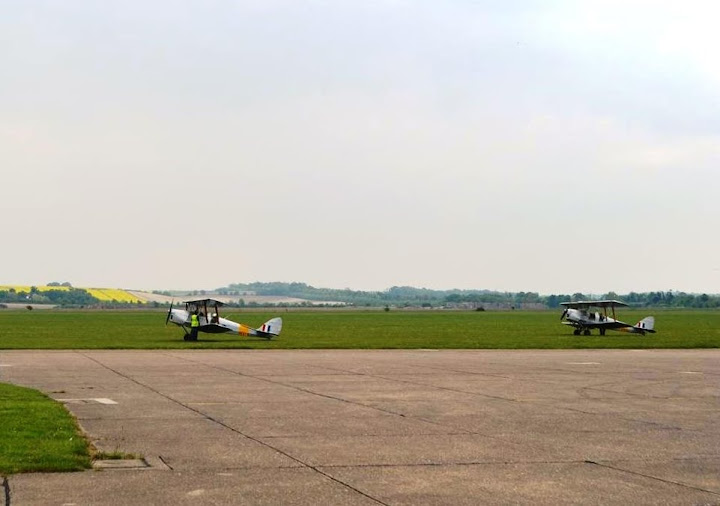
In each of our overseas holidays, my partner Alison and I seek to undertake some adventure which was slightly out of the ordinary or to do something that little bit different. We are not necessarily daredevils, but we occasionally seek to push the boundaries a little from the comfort zone of our life.
It was for this reason that I recently looked for an activity which would challenge me personally yet provide a sense of achievement once I had completed it. Being a nervous flyer at the best of times, I had decided that a flight or some form of aerial activity was probably the way to go. I was not yet brave enough to tackle a parachute jump or travel aloft in a hot air balloon, and I was probably too old to contemplate bungee jumping, so I decided to scour the internet for suggestions.
We were heading to the United Kingdom on our holidays, and intended to stay in Kent for at least a week. Being described as the garden of England, and having suffered numerous invasions throughout history, Kent boasts magnificent castles and protective structures dotting the picturesque countryside, in addition to the greenery of the landscape. With this type of scenery on offer, the thought of an aerial view was quite appealing.
To my delight, there are numerous operators offering aerial activities. I had a choice of flying in a helicopter and observing a World War II spitfire in flight, even flying in a modified Spitfire, participating in a Dambusters practice run, or flying in a Tiger Moth. My eye settled on the Tiger Moth flight and my mind flitted back to the visions of my youth. As far as I was concerned, the matter was settled. I was going to take the flight in the Tiger Moth. Alison on the other hand, indicated that she would settle for observation duties only and give a similar flight a miss.
After spending a delightful week in Kent, Alison and I made our way to a quaint airstrip called Headcorn, not far away from the large English town of Maidstone. This grass airstrip had first been used in 1927 when the landowner had flown from there with a group of friends. Opened in 1943 during the Second World War as Lashenden Airfield, it became a prototype for the temporary airfields built in France after D-Day. British, Canadian, and US airmen had used the airstrip during the War.

The weather was not looking too good that day, though conversely, it did not look too bad. It was not raining, and the clouds seemed to be higher than they had previously been during the last few days when it had been raining incessantly. This was of course the day that I had booked to take my Tiger Moth flight, and so I was very interested in the weather and the chances of taking the flight.
The conditions of the flight included one which indicated that in the event of unsuitable weather, the Club would reschedule the flight, but no refund would be given. The forecast for the next day was not good, so if it did not go ahead, my chances of taking a flight were slim, because we were due to head back to Australia on a more modern aircraft.
As we were staying reasonably close to the airstrip, we were relieved to see a hot air balloon drifting by a short distance away, and realised that this boded some promise for my flight. Around 9am I rang the aircraft operator, who informed me that the flight was definitely on.
The Tiger Moth I was going to fly is owned by a flying Club called the Tiger Club, and it was with this club that I had booked my flight. The Club owns only one Tiger Moth, but it is indeed a historic plane, for it was in fact the third DH82a Tiger Moth built and the second oldest still flying. It was registered on the 6th February 1933 and was impressed into war service in 1940 as a training aircraft. It was later auctioned off after the War, and in 1957, was acquired by the Tiger Club. It has been flown by the Club since then and had suffered a number of mishaps as well as one light crash, but was repaired each time.
I was apprehensively excited as we drove through the tiny back roads with flanked by high hedges and blind corners. Whilst there were passing bays carved from the surrounding countryside intermittently, the tiny road left little room to maneuver if a car came the other way. I remember thinking that maybe it would be safer in the Tiger Moth, given the dangers inherent in these tiny roads.

When we arrived at Headcorn, part of the administration building looked as if it were still rooted in the world of the 1940’s. The tiny parking area for the aerodrome most certainly didn’t seem to have been repaired since the Second World War, and the constant rain of the previous few days had exacerbated its condition. Large and small puddles in the parking area provided an interesting challenge.
Having negotiated our way around the puddles, we made our way into the tiny administration building, and were greeted warmly by the staff member, Jo. She was expecting us, and offered us a cup of tea in a very British voice. There were two others in the office, one of who turned out to be our pilot, Richard. They introduced themselves, and in our introductory conversation, Richard asked if I was a pilot or experienced in flying. When I responded with the quip that I was a person seeking to tackle his nervousness in flying, he paused momentarily before reassuring me as to the flight and outlining the interesting features of the flight that we could expect. It broke the ice, and we got on well immediately.
Though I did not know it at the time, Richard had been a pilot for over forty years, and had experienced his first solo flight when he was only seventeen. He had become an instructor at a very young age of 23 and developed a love of aerobatics. He evidently flew various planes and his son has followed his father's passion for flying, and is a member of Richard’s aerobatics team as well.
All this was unknown to me as I listened to his instructions and advice as to the intricacies of flying in a Tiger Moth. I had opted to book a 40 minute flight which gave more flying time, and I had requested that if possible, we fly over the white cliffs of Dover, which were some twenty from the Airstrip. I sought Richard’s confirmation that conditions were suitable to head in that direction. He advised me that that with beautifully calm conditions and little wind, it would be a very smooth flight and that it would not be a problem to make it to the white cliffs of Dover and back in the allotted time.
The next part of the formalities highlighted the changed world we live in. No doubt, many people would have flown in the Tiger Moth in its early years and never signed anything. However, with the increasingly litigious nature of our twenty first Century society, the Club protected itself legally by requiring me to sign away all my legal rights (and no doubt the rights of my estate) in the event of a more serious accident. I acknowledged the inherent risks of taking the flight and confirmed I was over the age of eighteen. Signing the paperwork was the only way I could take a flight - the added bonus was that this also made me a member of the Club.
Whilst I was completing the paperwork, Richard had gone out to “collect the plane”. I had anticipated seeing the Tiger Moth taxiing to a spot outside the Administration building, and was quite surprised to see Richard and the other Club member, Glenn, later dragging the Tiger Moth along behind them from a nearby hangar.
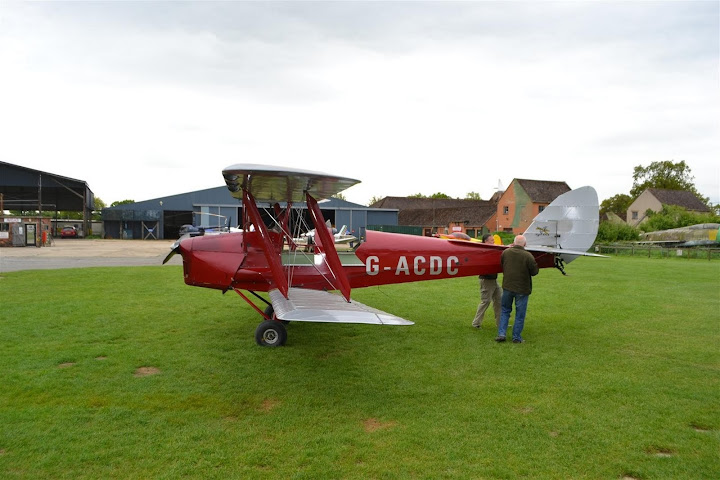
Richard and Glenn had fuelled the plane but still had to put oil in the engine as well as check the plane for anything untoward. For the next ten minutes, Richard walked around the plane and seemed to check every wire, strut, and moving part. For a nervous air traveler, the sight was very reassuring.
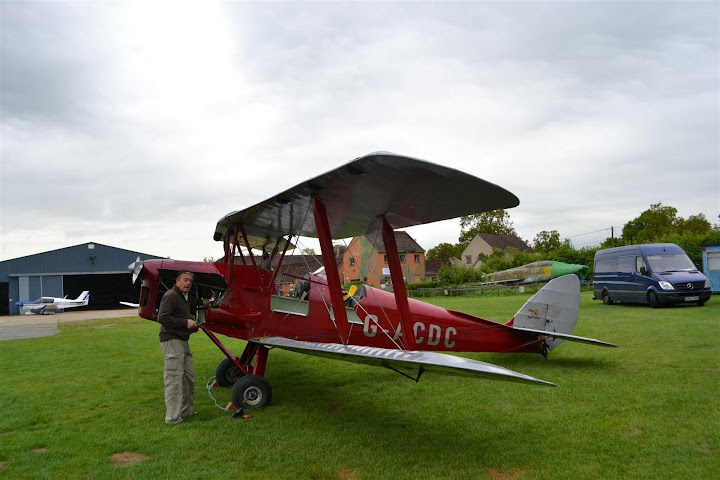
Once all the preliminaries had been dispensed with and Richard seemed satisfied with the mechanical condition of the plane, we were ready to head off on the flight. If there was to be any ceremony in leaving, it was the presentation to me of my flight helmet. Unlike the early period of its flying history, the flight helmet contained a small microphone which enabled the pilot and passenger to converse.
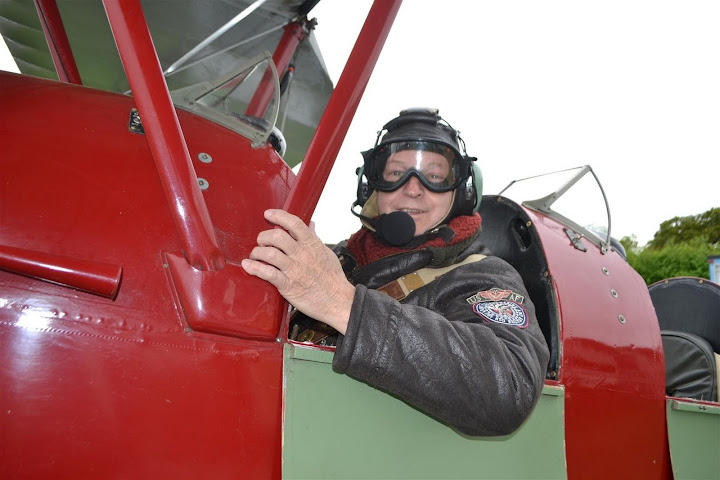
Richard expanded on his earlier general comments about the flight and keenly pointed out the various features and wires involved in the intricacies of flying the plane. To my surprise, he invited me to fly the plane on the way back from Dover. As thrilling as it sounded, I had my reservations and responded that I was happy for him to keep the controls. Even so, I was quite fascinated by the thought.
Without further delay, I was assisted by Glenn to climb into the front seat of the Tiger Moth. Stepping exactly where he pointed, I clumsily dropped into the seat and under Glenn’s instruction, we tested the intercom system. All seemed fine, and without further ado, Richard and Glenn readied for takeoff. Just as I had seen in countless movies, Glenn turned the propeller in a powerful lunging motion. After two or three attempts, the engine burst into life and a puff of smoke belched from the motor. The familiar throaty growl I remembered so well from the days of my youth as the planes flew overhead resonated around me. Richard conducted a series of tests on the wires and flaps while I looked around smugly in great excitement.
Having completed his preliminary checks, the increasing growl of the engine signaled that the taxi to the runway for takeoff was about to commence. After a cheerful wave to Alison, we sauntered off across the grassy area and headed towards the edge of the runway.
Whilst we were taxiing across the grass, I took the time to study the instrument panels of the Tiger moth. Compared to the photos I had seen of modern Jetliners, the panel was simple and crude. There was a speed indicator, an altimeter, a turn and slip indicator, and a compass trim. All seemed to be working well. The front cockpit I was sitting in was not roomy but more than adequate. The wires from the joystick and other controls used to fly the plane trailed down the side of the cockpit. That was the extent of the technology of the 1930’s.

After a short delay waiting for control tower approval to take off, Richard opened the throttle and the growl of the engine turned to a roar. With a gentle increase in speed, the plane careered down the runway and in a very short time became airborne. I had expected a certain bumpiness taking off on grass, but our takeoff was as smooth as the takeoff I had experienced in the A380 plane we had flown in from Dubai.
After our gentle rise through the air, we headed in an easterly direction towards Dover, and settled at a height of 1000-1100 feet. At that height, the scenery below was fascinating and most of the features of cars and houses were evident. I snapped away happily with my camera, taking copious quantities of photos.
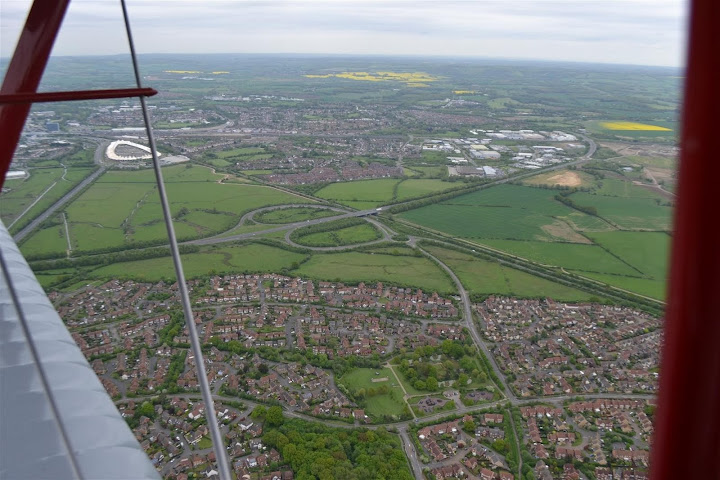
Perhaps the only unfortunate aspect of the flight was that despite it working on the ground before takeoff, my microphone did not seem to be working. Richard was providing a very informative commentary from behind me, and though I tried to respond or chip in with comments, it was clear that he was not hearing them. For his part, he probably assumed that I was in full agreement or just quiet. However, after I failed to respond a few times to a few comments or questions, he worked out that there was a difficulty in communication. We reached an understanding of the situation when he asked me to merely give him thumbs up or sign language if there were any problems.
Luckily, the problems dissipated a few minutes later when to my surprise, the microphone flickered back into life and we were able to communicate through the intercom. I explained to him that it must be a faulty cable, and my fidgeting with it seemed to at least resolve the problem for the moment.
The biggest issue after the intercom problem was the bitterly cold conditions at that altitude. Though I had worn a warm shirt, jumper, and coat for the flight (and had had some thoughts that I had dressed too warmly), the rush of cold air suggested that it was definitely needed. What I had not prepared for was that I probably should have taken gloves. As the flight progressed, my fingers started to ache from the cold. It was the only discomfort during the whole flight.
As we cruised at an altitude of 1100 feet and at a speed of 80 miles per hour, I ventured a quick look from behind the windscreen which sat on top of the huge engine block. Whilst I remained behind the windscreen I was protected from the wind factor, but when I poked my face around the side of the windscreen, the effect on my face was amazing. It was as if my lips and cheeks were blubbering away. It felt strange and must have looked quite funny.
After following the Motorway for some distance, we ended up flying over dazzling fields of yellow rapeseed (or canola fields) and the Euro Train tracks. Richard pointed out the features and seemed very proud of the countryside below him. He explained that on some days when there were reasonably strong head winds, the Tiger Moth struggled to make headway and the cars on the motorway travelled faster. I could imagine the drivers on the motorway glancing upwards at the old bi-plane slowly flying above them and knew that if I were driving, I would be doing exactly that.
A few minutes later, the train lines disappeared as the entrance to the rail tunnel under the English Channel came into view. Richard altered course and we headed towards the town of Folkestone before swinging towards Dover and its famous white cliffs.
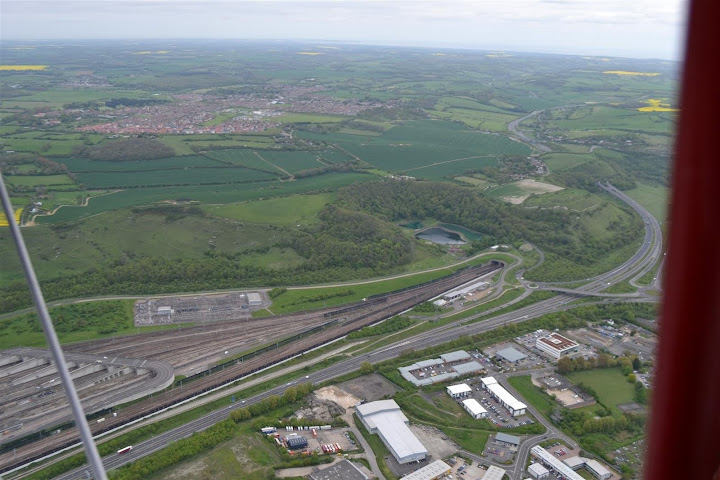
Being the area closest to the German occupied continent, the County of Kent had been in the foreground of the Battle of Britain in 1940. As we headed towards the port of Dover, Richard pointed out a giant memorial dedicated to the memory of the “glorious few” who had done so much in the Battle of Britain. The memorial was in the shape of a Spitfire propeller and best visible from the air.
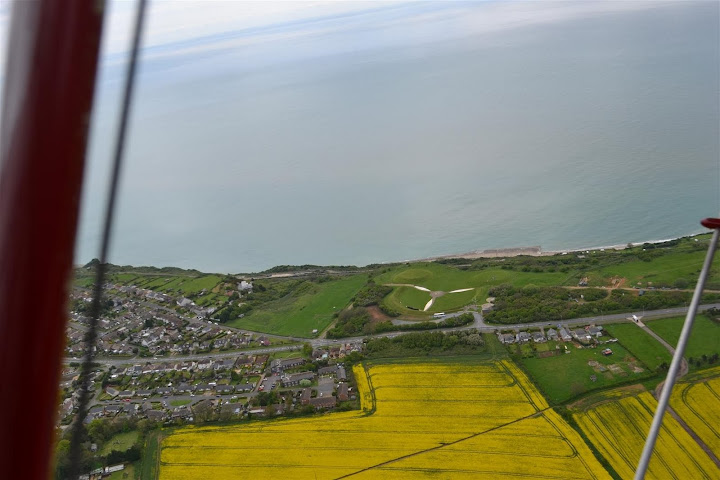
When we arrived over Dover a short time later, Richard banked into a tight turn over the historic and iconic Dover Castle, which provided a magnificent view of the features. It was the first real banking of the plane and an exhilarating experience. As we circled around the castle, Richard spoke warmly and proudly of its history.
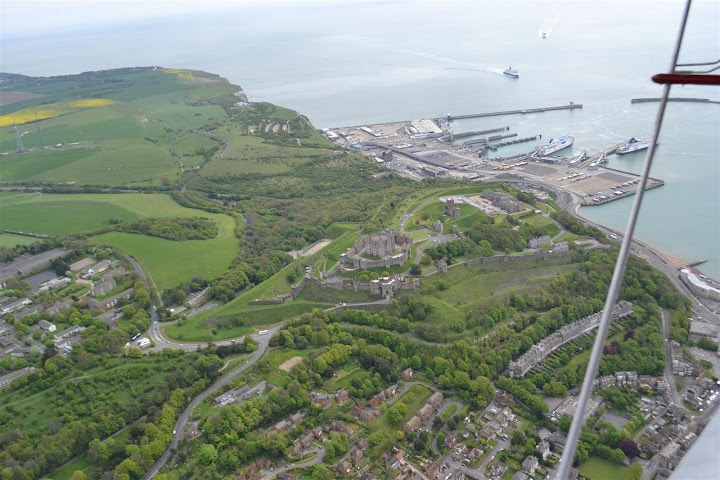
He also pointed out the channel ferries queuing outside the harbour to berth. We passed a giant aerial about 700 feet high whose top part was not much lower than our flying height of 1100 feet.
The highlight of my flight was about to start. Only a few miles further up the coast were the almighty white cliffs of Dover. Richard headed slightly out to sea which provided a great opportunity to view them. With the cliffs being some 600 feet high, and our flight height being 1100 feet above sea level, we were only 500 feet above the cliffs. Momentarily, I thought of the British and German pilots who had seen those very same sights as they flew into action during the Second World War. I wondered how many of those pilots had not returned from their momentous flights.

After one trip flying parallel to the cliffs, Richard circled out to sea for a return run over the cliffs on the way back. It was simply exhilarating and a wonderful memory for the future.

As we made our way back towards Dover, we again passed over Dover Castle before heading back towards the airstrip at Headcorn. Richard chose a slightly different course for our journey home but kept the Motorway and the distant railway line on our left as we flew over the yellow and green fields.
As we were now some twenty minutes away from Headcorn, Richard suggested that I take control. As apprehensive as I was about taking the controls of the plane, the thought of it was exciting and so after a pause, I indicated my willingness. With a waggle of the joystick which was the signal from him to me that he was passing control of the plane, I assumed the flying role. Of course, I was well aware that Richard was only an intercom plea away, so I set out to enjoy my time as “the pilot”. He had provided some rudimentary instructions just before our departure, so I did have some clues.
Richard set my first task when he asked me to steer towards the confluence of the motorway and railway line as they slowly converged. This sounded easy in theory, but much harder in practice. I managed to turn the plane, but as I did, the nose of the plane pushed upwards. This meant pushing the joystick down, and adjusting the direction yet again. Despite some difficulty, I finally managed to achieve my aim and could then afford to relax and look at the countryside below as well as the dials in front of me.
After some ten minutes of me in control of the aircraft, I voluntarily handed control back to Richard. We reversed the joystick waggling scenario and with an inward sigh of relief on probably his and my part, he assumed control. The experience meant that I had actually flown my first plane, though given my non-comfort zone in the air, I had probably flown many planes each time I had taken off on a commercial flight.
The final excitement of my journey came as we neared Headcorn airport. We had begun to lose height slowly and steadily and Richard had informed me that he was going to make a low pass over the airfield. We would then circle around and make the landing. We were at about 800 feet when Richard dropped the plane quickly and suddenly into the low level pass of the airfield at a height around two hundred and fifty feet. It felt exhilarating and the excitement of the flight picked up again. From her vantage point just near the clubhouse, Alison was videoing the event and was no doubt expecting us to land. I could clearly see her as we swooped past and when I later heard her video commentary on the movie she was filming, it definitely caught her unawares. A second short circular route back around the nearby countryside brought us gently down to earth and the Tiger Moth lightly touched down on the runway.
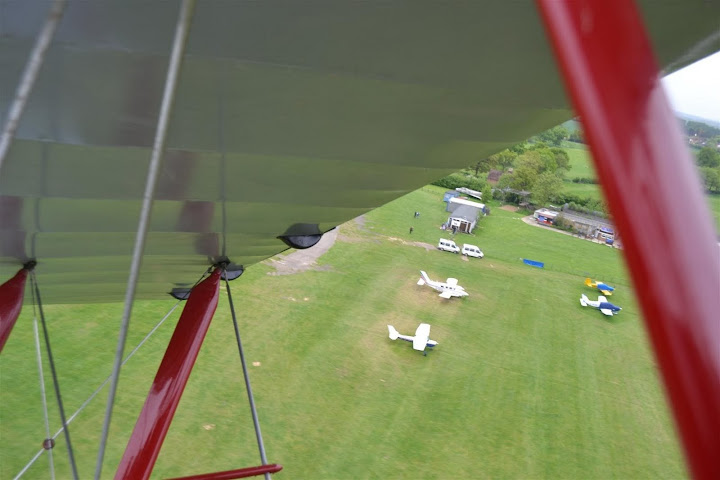
As we taxied back to the administration building, the next client for Richard was waiting. I found out later that he was a 70 year old man whose family had bought him the flight. They were madly taking photos of the plane as we taxied in. Richard and I got out of the plane, and had a short and friendly conversation. He was a busy man so I thanked him, shook his hand, and took my leave. He had been a wonderful pilot and teacher.
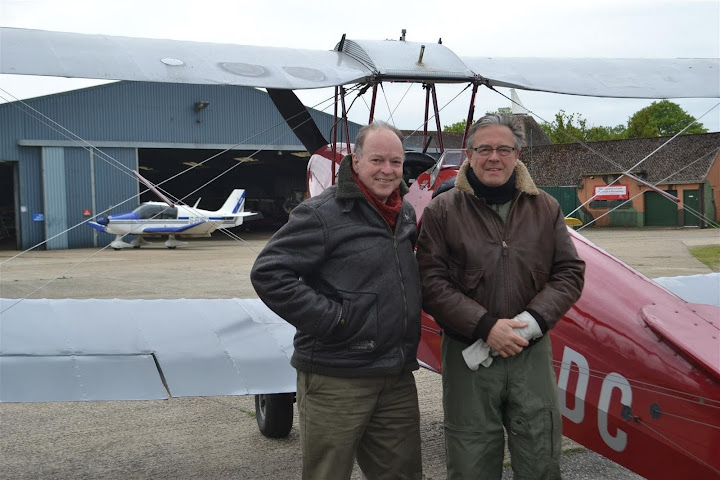
There is no doubt that the flight was a high point of my holiday, and the experience had been wonderful. In the short time that I had known Richard, he had impressed with his approach, manner, and professionalism. More than that, I had challenged myself to push my own boundaries just that little bit further. Many people did infinitely more exciting things every day throughout the world, but to make contact with a small piece of aviation history and to fly in an area where so many had gallantly fought and died, brought a small connection with history. It was just a different way of visiting history in the same manner that one visited castles and cathedrals to try to imagine what those buildings were like in their historical context. This flimsy machine from the 1930’s had brought just a little more intense appreciation for those that had gone before us.
Read more of Wido's journeys:
